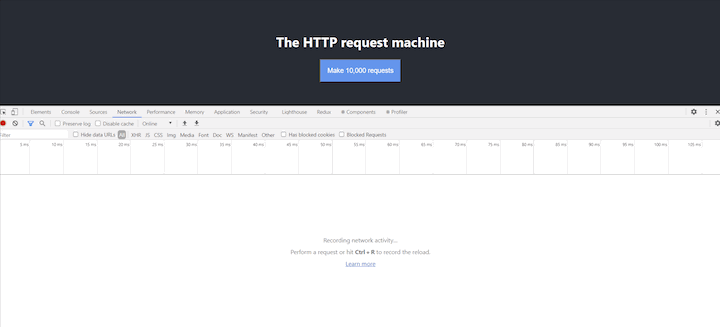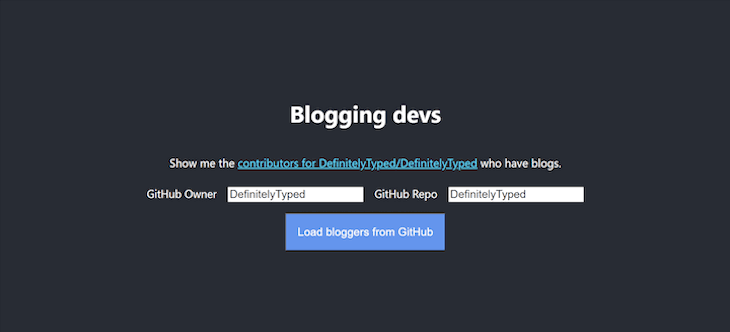
When an application loads data, typically, relatively few HTTP requests are made. For example, if we imagine we’re making a student administration application, then a “view” screen might make a single HTTP request to load that student’s data before displaying it.

Occasionally, there’s a need for an application to make a large number of HTTP requests. Consider a reporting application that loads data and then aggregates it for presentation purposes.
This need presents two interesting problems:
In this tutorial, we’ll demonstrate how to tackle these issues using a custom React Hook.
The Replay is a weekly newsletter for dev and engineering leaders.
Delivered once a week, it's your curated guide to the most important conversations around frontend dev, emerging AI tools, and the state of modern software.
We’ll begin our journey by spinning up a TypeScript React app with Create React App.
npx create-react-app throttle-requests-react-hook --template typescript
Because we’re going to make a number of asynchronous calls, we’ll simplify the code by leaning on the widely used react-use for a useAsync hook.
cd throttle-requests-react-hook yarn add react-use
We’ll replace the App.css file with this:
.App {
text-align: center;
}
.App-header {
background-color: #282c34;
min-height: 100vh;
display: flex;
flex-direction: column;
align-items: center;
justify-content: center;
font-size: calc(10px + 2vmin);
color: white;
}
.App-labelinput > * {
margin: 0.5em;
font-size:24px;
}
.App-link {
color: #61dafb;
}
.App-button {
font-size: calc(10px + 2vmin);
margin-top: 0.5em;
padding: 1em;
background-color: cornflowerblue;
color: #ffffff;
text-align: center;
}
.App-progress {
padding: 1em;
background-color: cadetblue;
color: #ffffff;
}
.App-results {
display: flex;
flex-wrap: wrap;
}
.App-results > * {
padding: 1em;
margin: 0.5em;
background-color: darkblue;
flex: 1 1 300px;
}
Then, we’ll replace the App.tsx contents with this:
import React, { useState } from "react";
import { useAsync } from "react-use";
import "./App.css";
function use10_000Requests(startedAt: string) {
const responses = useAsync(async () => {
if (!startedAt) return;
// make 10,000 unique HTTP requests
const results = await Promise.all(
Array.from(Array(10_000)).map(async (_, index) => {
const response = await fetch(
`/manifest.json?querystringValueToPreventCaching=${startedAt}_request-${index}`
);
const json = await response.json();
return json;
})
);
return results;
}, [startedAt]);
return responses;
}
function App() {
const [startedAt, setStartedAt] = useState("");
const responses = use10_000Requests(startedAt);
return (
<div className="App">
<header className="App-header">
<h1>The HTTP request machine</h1>
<button
className="App-button"
onClick={(_) => setStartedAt(new Date().toISOString())}
>
Make 10,000 requests
</button>
{responses.loading && <div>{progressMessage}</div>}
{responses.error && <div>Something went wrong</div>}
{responses.value && (
<div className="App-results">
{responses.value.length} requests completed successfully
</div>
)}
</header>
</div>
);
}
export default App;
The app we’ve built is very simple: it’s a button that, when you press it, fires 10,000 HTTP requests in parallel using the Fetch API. The data being requested in this case is an arbitrary JSON file: the manifest.json. If you look closely, you’ll see we’re doing some querystring tricks with our URL to avoid getting cached data.
In fact, for this demo, we’re not interested in the results of these HTTP requests. Rather, we’re interested in how the browser copes with this approach (spoiler: not well). It’s worth considering that requesting a text file from a server running on the same machine as the browser should be fast.
So we’ll run yarn start and go to http://localhost:3000 to get to the app. Running with Devtools open results in the following unhappy affair:

The gif above has been edited significantly for brevity. In reality, it took 20 seconds for the first request to be fired. Prior to that, Chrome was unresponsive. When requests did start to fire, a significant number failed with net::ERR_INSUFFICIENT_RESOURCES. Requests that were fired sat in a “Stalled” state prior to being executed. This is a consequence of Chrome limiting the number of connections (all browsers do this):
There are already six TCP connections open for this origin, which is the limit. Applies to HTTP/1.0 and HTTP/1.1 only.
In summary, the problems with the current approach are threefold:
Instead of hammering the browser by firing all the requests at once, we could instead implement a throttle. A throttle is a mechanism that allows you to limit the rate at which operations are performed.
In this case, we want to limit the rate at which HTTP requests are made. A throttle will tackle the first two problems, essentially keeping the browser free and easy and ensuring that requests are successfully sent. We also want to keep our users informed about how progress is going.
It’s time to unveil the useThrottleRequests hook:
import { useMemo, useReducer } from "react";
import { AsyncState } from "react-use/lib/useAsync";
/** Function which makes a request */
export type RequestToMake = () => Promise<void>;
/**
* Given an array of requestsToMake and a limit on the number of max parallel requests
* queue up those requests and start firing them
* - inspired by Rafael Xavier's approach here: https://stackoverflow.com/a/48007240/761388
*
* @param requestsToMake
* @param maxParallelRequests the maximum number of requests to make - defaults to 6
*/
async function throttleRequests(
requestsToMake: RequestToMake[],
maxParallelRequests = 6
) {
// queue up simultaneous calls
const queue: Promise<void>[] = [];
for (let requestToMake of requestsToMake) {
// fire the async function, add its promise to the queue,
// and remove it from queue when complete
const promise = requestToMake().then((res) => {
queue.splice(queue.indexOf(promise), 1);
return res;
});
queue.push(promise);
// if the number of queued requests matches our limit then
// wait for one to finish before enqueueing more
if (queue.length >= maxParallelRequests) {
await Promise.race(queue);
}
}
// wait for the rest of the calls to finish
await Promise.all(queue);
}
/**
* The state that represents the progress in processing throttled requests
*/
export type ThrottledProgress<TData> = {
/** the number of requests that will be made */
totalRequests: number;
/** the errors that came from failed requests */
errors: Error[];
/** the responses that came from successful requests */
values: TData[];
/** a value between 0 and 100 which represents the percentage of requests that have been completed (whether successfully or not) */
percentageLoaded: number;
/** whether the throttle is currently processing requests */
loading: boolean;
};
function createThrottledProgress<TData>(
totalRequests: number
): ThrottledProgress<TData> {
return {
totalRequests,
percentageLoaded: 0,
loading: false,
errors: [],
values: [],
};
}
/**
* A reducing function which takes the supplied `ThrottledProgress` and applies a new value to it
*/
function updateThrottledProgress<TData>(
currentProgress: ThrottledProgress<TData>,
newData: AsyncState<TData>
): ThrottledProgress<TData> {
const errors = newData.error
? [...currentProgress.errors, newData.error]
: currentProgress.errors;
const values = newData.value
? [...currentProgress.values, newData.value]
: currentProgress.values;
const percentageLoaded =
currentProgress.totalRequests === 0
? 0
: Math.round(
((errors.length + values.length) / currentProgress.totalRequests) * 100
);
const loading =
currentProgress.totalRequests === 0
? false
: errors.length + values.length < currentProgress.totalRequests;
return {
totalRequests: currentProgress.totalRequests,
loading,
percentageLoaded,
errors,
values,
};
}
type ThrottleActions<TValue> =
| {
type: "initialise";
totalRequests: number;
}
| {
type: "requestSuccess";
value: TValue;
}
| {
type: "requestFailed";
error: Error;
};
/**
* Create a ThrottleRequests and an updater
*/
export function useThrottleRequests<TValue>() {
function reducer(
throttledProgressAndState: ThrottledProgress<TValue>,
action: ThrottleActions<TValue>
): ThrottledProgress<TValue> {
switch (action.type) {
case "initialise":
return createThrottledProgress(action.totalRequests);
case "requestSuccess":
return updateThrottledProgress(throttledProgressAndState, {
loading: false,
value: action.value,
});
case "requestFailed":
return updateThrottledProgress(throttledProgressAndState, {
loading: false,
error: action.error,
});
}
}
const [throttle, dispatch] = useReducer(
reducer,
createThrottledProgress<TValue>(/** totalRequests */ 0)
);
const updateThrottle = useMemo(() => {
/**
* Update the throttle with a successful request
* @param values from request
*/
function requestSucceededWithData(value: TValue) {
return dispatch({
type: "requestSuccess",
value,
});
}
/**
* Update the throttle upon a failed request with an error message
* @param error error
*/
function requestFailedWithError(error: Error) {
return dispatch({
type: "requestFailed",
error,
});
}
/**
* Given an array of requestsToMake and a limit on the number of max parallel requests
* queue up those requests and start firing them
* - based upon https://stackoverflow.com/a/48007240/761388
*
* @param requestsToMake
* @param maxParallelRequests the maximum number of requests to make - defaults to 6
*/
function queueRequests(
requestsToMake: RequestToMake[],
maxParallelRequests = 6
) {
dispatch({
type: "initialise",
totalRequests: requestsToMake.length,
});
return throttleRequests(requestsToMake, maxParallelRequests);
}
return {
queueRequests,
requestSucceededWithData,
requestFailedWithError,
};
}, [dispatch]);
return {
throttle,
updateThrottle,
};
}
The useThrottleRequests hook returns two properties:
throttle, a ThrottledProgress<TData> that contains the following data:
totalRequests, the number of requests that will be madeerrors, the errors that come from failed requestsvalues, the responses that come from successful requestspercentageLoaded, a value between 0 and 100 that represents the percentage of requests that have been completed (successfully or not)loading, whether the throttle is currently processing requestsupdateThrottle, an object that exposes three functions:
queueRequests, the function to which you pass the requests that should be queued and executed in a throttled fashionrequestSucceededWithData, the function that is called if a request succeeds to provide the datarequestFailedWithError, the function that is called if a request fails to provide the errorThat’s a lot of words to describe our useThrottleRequests hook. Let’s see what it looks like by migrating our use10_000Requests hook to use it.
Here’s a new implementation of App.tsx:
import React, { useState } from "react";
import { useAsync } from "react-use";
import { useThrottleRequests } from "./useThrottleRequests";
import "./App.css";
function use10_000Requests(startedAt: string) {
const { throttle, updateThrottle } = useThrottleRequests();
const [progressMessage, setProgressMessage] = useState("not started");
useAsync(async() => {
if (!startedAt) return;
setProgressMessage("preparing");
const requestsToMake = Array.from(Array(10_000)).map(
(_, index) => async () => {
try {
setProgressMessage(`loading ${index}...`);
const response = await fetch(
`/manifest.json?querystringValueToPreventCaching=${startedAt}_request-${index}`
);
const json = await response.json();
updateThrottle.requestSucceededWithData(json);
} catch (error) {
console.error(`failed to load ${index}`, error);
updateThrottle.requestFailedWithError(error);
}
}
);
await updateThrottle.queueRequests(requestsToMake);
}, [startedAt, updateThrottle, setProgressMessage]);
return { throttle, progressMessage };
}
function App() {
const [startedAt, setStartedAt] = useState("");
const { progressMessage, throttle } = use10_000Requests(startedAt);
return (
<div className="App">
<header className="App-header">
<h1>The HTTP request machine</h1>
<button
className="App-button"
onClick={(_) => setStartedAt(new Date().toISOString())}
>
Make 10,000 requests
</button>
{throttle.loading && <div>{progressMessage}</div>}
{throttle.values.length > 0 && (
<div className="App-results">
{throttle.values.length} requests completed successfully
</div>
)}
{throttle.errors.length > 0 && (
<div className="App-results">
{throttle.errors.length} requests errored
</div>
)}
</header>
</div>
);
}
export default App;
Looking at the new use10_000Requests hook, there are a few subtle differences from our prior implementation. For starters, we’re now exposing the throttle, a ThrottleProgress<TData>. Our updated hook also exposes a progressMessage, which is a simple string stored with useState that we update as our throttle runs.
In truth, the information being surfaced here isn’t that interesting. The progressMessage is in place just to illustrate that you could capture some data from your requests as they complete for display purposes — a running total, for instance.
So, how does our new hook approach perform?

It performs very well, indeed! Again, the gif above has again been edited for brevity. If we look back at the problems we faced with the prior approach, how do we compare?
Tremendous!
Our current example is definitely contrived. Let’s apply our useThrottleRequests hook to a more realistic scenario.
We’re going to build an application that, given a repo on GitHub, lists all the contributors’ blogs. You can specify a blog URL on your GitHub profile; many people use this to specify their Twitter profile.
We can build this thanks to the excellent GitHub REST API, which exposes two endpoints of interest given our goal: list repository contributors and get a user.
List repository contributors lists contributors to the specified repository at this URL: GET https://api.github.com/repos/{owner}/{repo}/contributors. The response is an array of objects, crucially featuring a url property that points to the user’s API endpoint.
[
// ...
{
// ...
"url": "https://api.github.com/users/octocat",
// ...
},
// ...
]
Get a user is the API that the url property above is referring to. When called, it returns an object representing the publicly available information about a user.
{
// ...
"name": "The Octocat",
// ...
"blog": "https://github.blog",
// ...
}
We’re now ready to build our blogging devs app. Let’s replace the existing App.tsx with:
import React, { useCallback, useMemo, useState } from "react";
import { useAsync } from "react-use";
import { useThrottleRequests } from "./useThrottleRequests";
import "./App.css";
type GitHubUser = { name: string; blog?: string };
function timeout(ms: number) {
return new Promise((resolve) => setTimeout(resolve, ms));
}
function useContributors(contributorsUrlToLoad: string) {
const { throttle, updateThrottle } = useThrottleRequests<GitHubUser>();
const [progressMessage, setProgressMessage] = useState("");
useAsync(async () => {
if (!contributorsUrlToLoad) return;
setProgressMessage("loading contributors");
// load contributors from GitHub
const contributorsResponse = await fetch(contributorsUrlToLoad);
const contributors: { url: string }[] = await contributorsResponse.json();
setProgressMessage(`loading ${contributors.length} contributors...`);
// For each entry in result, retrieve the given user from GitHub
const requestsToMake = contributors.map(({ url }, index) => async () => {
try {
setProgressMessage(
`loading ${index} / ${contributors.length}: ${url}...`
);
const response = await fetch(url);
const json: GitHubUser = await response.json();
// wait for 1 second before completing the request
// - makes for better demos
await timeout(1000);
updateThrottle.requestSucceededWithData(json);
} catch (error) {
console.error(`failed to load ${url}`, error);
updateThrottle.requestFailedWithError(error);
}
});
await updateThrottle.queueRequests(requestsToMake);
setProgressMessage("");
}, [contributorsUrlToLoad, updateThrottle, setProgressMessage]);
return { throttle, progressMessage };
}
function App() {
// The owner and repo to query; we're going to default
// to using DefinitelyTyped as an example repo as it
// is one of the most contributed to repos on GitHub
const [owner, setOwner] = useState("DefinitelyTyped");
const [repo, setRepo] = useState("DefinitelyTyped");
const handleOwnerChange = useCallback(
(event: React.ChangeEvent<HTMLInputElement>) =>
setOwner(event.target.value),
[setOwner]
);
const handleRepoChange = useCallback(
(event: React.ChangeEvent<HTMLInputElement>) => setRepo(event.target.value),
[setRepo]
);
const contributorsUrl = `https://api.github.com/repos/${owner}/${repo}/contributors`;
const [contributorsUrlToLoad, setUrlToLoad] = useState("");
const { progressMessage, throttle } = useContributors(contributorsUrlToLoad);
const bloggers = useMemo(
() => throttle.values.filter((contributor) => contributor.blog),
[throttle]
);
return (
<div className="App">
<header className="App-header">
<h1>Blogging devs</h1>
<p>
Show me the{" "}
<a
className="App-link"
href={contributorsUrl}
target="_blank"
rel="noopener noreferrer"
>
contributors for {owner}/{repo}
</a>{" "}
who have blogs.
</p>
<div className="App-labelinput">
<label htmlFor="owner">GitHub Owner</label>
<input
id="owner"
type="text"
value={owner}
onChange={handleOwnerChange}
/>
<label htmlFor="repo">GitHub Repo</label>
<input
id="repo"
type="text"
value={repo}
onChange={handleRepoChange}
/>
</div>
<button
className="App-button"
onClick={(e) => setUrlToLoad(contributorsUrl)}
>
Load bloggers from GitHub
</button>
{progressMessage && (
<div className="App-progress">{progressMessage}</div>
)}
{throttle.percentageLoaded > 0 && (
<>
<h3>Behold {bloggers.length} bloggers:</h3>
<div className="App-results">
{bloggers.map((blogger) => (
<div key={blogger.name}>
<div>{blogger.name}</div>
<a
className="App-link"
href={blogger.blog}
target="_blank"
rel="noopener noreferrer"
>
{blogger.blog}
</a>
</div>
))}
</div>
</>
)}
{throttle.errors.length > 0 && (
<div className="App-results">
{throttle.errors.length} requests errored
</div>
)}
</header>
</div>
);
}
export default App;
The application enables users to enter the organization and repository of a GitHub project. Then, when the button is clicked, it:
Just to make the demo a little clearer, we’ve artificially slowed the duration of each request by a second. Here’s what it looks like when you put it together:

We have built a React Hook that allows us to gradually load data without blocking the UI of the browser and provides progress data to keep users informed.
Install LogRocket via npm or script tag. LogRocket.init() must be called client-side, not
server-side
$ npm i --save logrocket
// Code:
import LogRocket from 'logrocket';
LogRocket.init('app/id');
// Add to your HTML:
<script src="https://cdn.lr-ingest.com/LogRocket.min.js"></script>
<script>window.LogRocket && window.LogRocket.init('app/id');</script>

AI-first debugging augments traditional debugging with log clustering, pattern recognition, and faster root cause analysis. Learn where AI helps, where it fails, and how to use it safely in production.

Container queries let components respond to their own layout context instead of the viewport. This article explores how they work and where they fit alongside media queries.

React Server Components vs Islands Architecture: Learn how each reduces client JavaScript, impacts hydration and interactivity, and which trade-offs matter for production performance.

Large hosted LLMs aren’t always an option. Learn how to build agentic AI with small, local models that preserve privacy and scale.
Would you be interested in joining LogRocket's developer community?
Join LogRocket’s Content Advisory Board. You’ll help inform the type of content we create and get access to exclusive meetups, social accreditation, and swag.
Sign up now